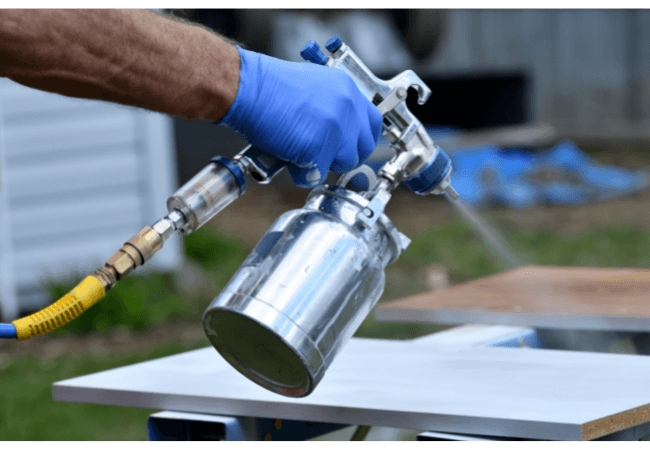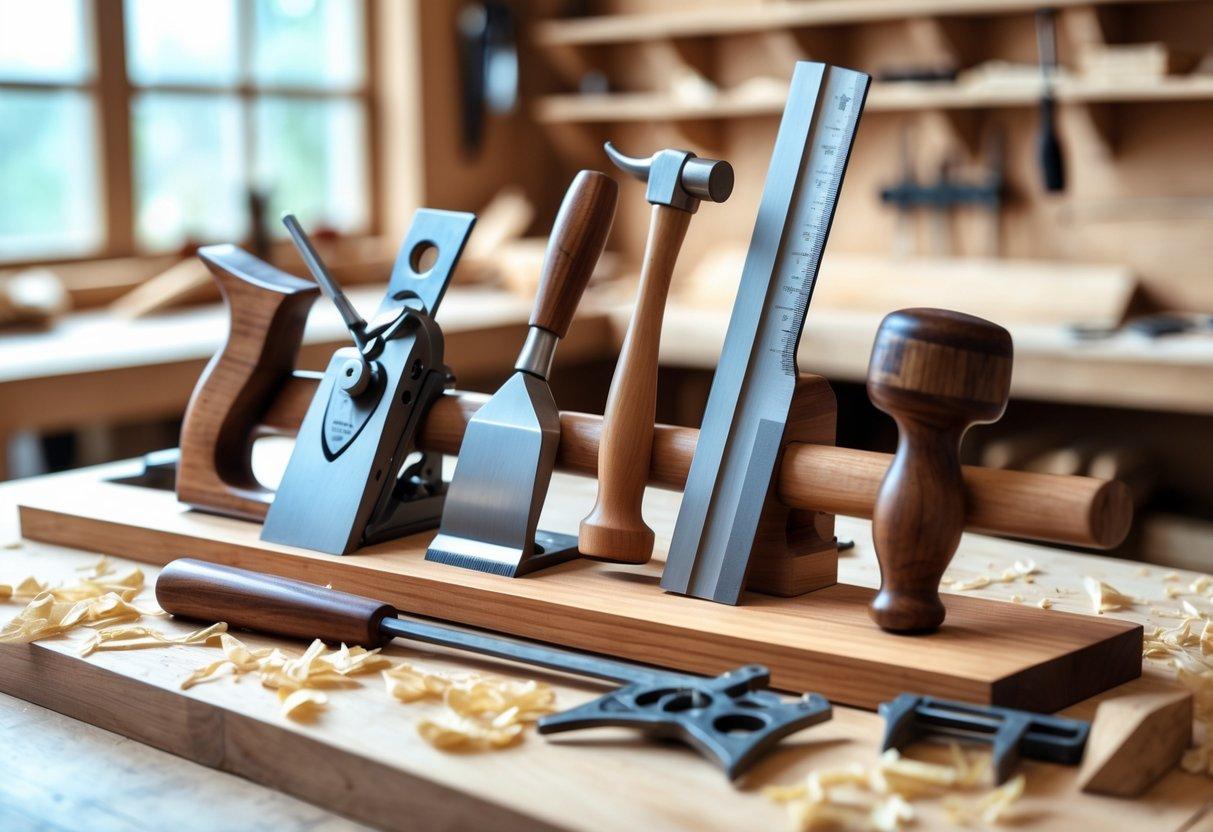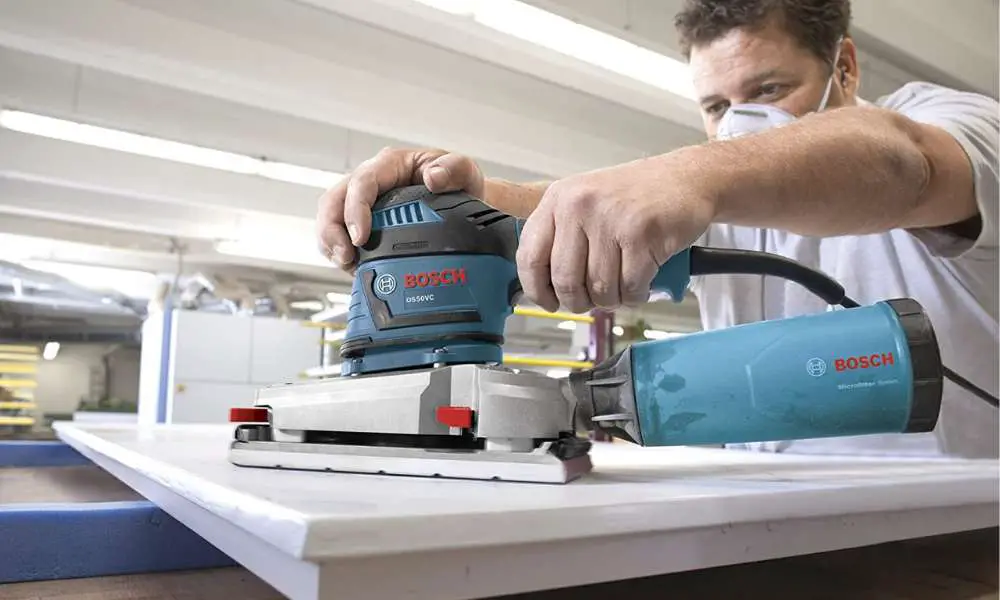When it comes to painting the outside of a house, homeowners have to decide between two common methods: rolling and spraying. Each has its pros and cons that affect the quality, durability, and look of the finished paint job. In this article, we will give you the lowdown on both rolling and spraying and help you decide which one is best for you.
Painting with a roller gives you more control over the thickness and coverage of the paint, which can result in a more even and uniform finish. Spraying is quicker and more efficient and can cover large areas in less time than rolling. But it requires more skill and experience to get the best result. Factors like the type of paint, surface texture, weather, and desired finish must be considered when choosing the right method for your exterior painting project.
Contents
Key Points
- Both rolling and spraying have their own advantages and challenges
- Surface texture, paint type, and weather affect the choice
- Efficiency, skill level, and desired finish play a role in the decision
Rolling vs Spraying
Rolling Benefits
- Control: Rolling gives you better control, resulting in an even and consistent application. DIYers can achieve a professional look without the need for advanced skills.
- Penetration: Because of the direct pressure applied, paint can penetrate into the surface and adhere better. This results to a longer lasting finish.
- Cost-effective: Rolling doesn’t require expensive equipment or machinery. Rollers, paint trays, and extension poles are generally more affordable.
- Less overspray: Rolling minimizes paint wastage, reducing overall cost and cleanup efforts.
Spraying Benefits
- Speed: Spraying is faster than rolling, perfect for large projects or tight deadlines.
- Versatility: Sprayers can reach areas that rollers can’t, like nooks, crannies and intricate architectural details.
- Smooth finish: Sprayed paint dries to a smooth and seamless finish, free from brush strokes and unwanted roller marks.
- Multiple coatings: Sprayers can apply different types of coatings, primer, paint and clear coats all in one go.Both has its benefits and the choice depends on your project requirements, budget and desired results. Ultimately, rolling is for those who want more control and cost-effective solutions while spraying is for larger projects and a fast smooth finish.
Choosing a Method
When deciding to roll or spray exterior house paint, there are several factors to consider. In this section,n we will look into the type of paint, house exterior material, weather conditions, and labor and time constraints which can all affect the choice of method.
Type of Paint
When choosing a method, consider the type of paint being used. Oil-based paints are generally better for spraying because of its smooth application and slow drying time. Water-based (latex) paints can work with both rolling and spraying. Check the paint manufacturer’s recommendation for the preferred application method.
House Exterior Material
The material of the house exterior also plays a role in the choice between rolling and spraying. For example:
- Wood siding: Both can work, but spraying may be better for textured surfaces or hard-to-reach areas.
- Brick or stucco: Rolling can cause an uneven finish on these materials, so spraying is generally recommended.
- Aluminum or vinyl siding: Both can work depending on the condition and texture of the surface.
Weather Conditions
Outdoor painting requires planning around weather conditions. When deciding to roll or spray the paint, consider these factors:
- Temperature: Both methods are affected by temperature, but spraying may be more sensitive to extreme conditions. Don’t spray when the temperature is below 50°F (10°C) or above 90°F (32°C).
- Humidity: High humidity can slow down water-based paints from drying, making it harder to achieve a smooth finish when rolling. Spraying may perform better in high humidity, depending on the paint type.
- Wind: Spraying paint in windy conditions can cause overspray and uneven coverage. Rolling may be safer in such situations.
Labor and Time Constraints
Finally, one must consider labor and time when deciding between rolling and spraying. Here’s a quick comparison:
- Rolling requires more physical effort and takes longer, especially on large surfaces or uneven textures. However, it requires less preparation and cleanup than spraying.
- Spraying is faster and less labor-intensive but often requires more masking and covering to protect surfaces from overspray. And the equipment needs thorough cleaning after use.
By considering the paint type, house exterior material, weather conditions, and labor and time constraints when choosing a method, homeowners and professionals can make better decisions on how to paint home exteriors.
Equipment and Tools

Roller Tools and Supplies
When using a roller to paint the exterior of your house, you will need the right tools and supplies. First, you’ll need a high-quality paint roller with an extension pole to reach higher areas. Choose a roller with a 3/4-inch nap for textured surfaces or a 3/8-inch nap for smoother surfaces.
Other necessary tools:
- Paint tray: to hold the paint and distribute it evenly onto the roller
- Drop cloths: to protect surfaces from paint spills and splatters
- Painter’s tape: to mask off windows, doors, and trim
- Ladder or scaffolding: to reach higher areas safely
- Brushes: for cutting in the edges and tight spots where a roller won’t fit
Make sure to maintain your roller tools by cleaning them regularly and storing them properly to ensure smooth paint application.
Sprayer Equipment and Maintenance
Spraying exterior paint requires specific equipment and maintenance. The main tool is a paint sprayer, which can be an airless sprayer or an HVLP (high-volume, low-pressure) sprayer. Airless sprayers are more powerful and faster, while HVLP sprayers provide better control and a smoother finish.
The following are the necessary accessories for a paint sprayer:
- Spray tips: in various sizes for different types of paint and surface conditions
- Filters: to prevent clogging and ensure smooth paint flow
- Hoses: to connect the sprayer to the paint container and the gun
- Safety equipment: goggles, respiratory masks, and protective clothingProper maintenance of your paint sprayer is key to optimal performance and longevity. Inspect and clean filters, spray tips, and hoses regularly. Check for leaks and wear on all parts and replace any damaged components immediately. Always clean your sprayer after each use and store it in a dry place, away from dust and temperature fluctuations.
Techniques for Rolling and Spraying
Roller Technique
When using a roller to paint your home’s exterior, you need to choose the right nap size. For rough surfaces like stucco, choose a thicker nap (3/4 to 1 inch), and for smoother surfaces, choose a thinner nap (3/8 to 1/2 inch).
Before you start:
- Prime the roller by dampening it slightly and rolling it on a drop cloth or roller tray.
- Mix the paint thoroughly to ensure even color and consistency.
When applying paint:
- Work in sections, 4×4 feet.
- Use a W-pattern for even coverage: paint a large W on the surface, then fill in the gaps without lifting the roller.
- After completing a section, blend the edges into adjacent areas with light, vertical strokes.
Spraying Technique
Spraying provides a smooth finish but requires more preparation:
- Ensure surface is clean: remove dirt, grease, and debris.
- Mask off windows, doors, and other surfaces not to be painted.
- Use the right tip size for the paint being used. Check the paint manufacturer’s recommendation.
While spraying:
- Hold the spray gun perpendicular to the surface, 12 inches away.
- Maintain a steady pace.
- Overlap each pass by 50% for even coverage.
Note: Spraying technique may vary depending on the type of paint sprayer.
TechniquePrep TimeApplication TimeCleanup TimeRollerLowMediumLowSprayerHighFastHigh
Both rolling and spraying have pros and cons. Rolling requires less prep and cleanup but takes longer to apply. Spraying is faster to apply but demands more time for prep and cleanup. Ultimately the choice depends on the individual’s skill level, surface condition and personal preference.
Safety Precautions and Cleanup
Roller Safety
When using rollers for exterior painting, you need to take certain safety measures to ensure a safe working environment
1. Wear proper gear: Gloves, goggles, and a mask when handling paint to avoid skin irritation and inhaling harmful chemicals.
- Use the right ladder: Always use a sturdy and stable ladder that extends beyond the work area, with slip-resistant feet to prevent falls.
- Keep the workspace clean: Keep tools organized and the area clear of debris to avoid tripping hazards.
- Don’t overreach: Instead of leaning to reach further, reposition your ladder to avoid being off balance.
Sprayer Safety and Cleanup
Spraying exterior house paint requires additional precautions during the painting and cleanup process.
- Safety gear: Along with the safety gear mentioned for roller painting, you need to wear a respirator to protect yourself from airborne paint particles when using a sprayer.
- Proper ventilation: Always spray in well-ventilated areas to prevent paint fumes and particles from building up, which can be harmful when inhaled.
Cleanup procedures for sprayers should be followed:
- Depressurize the sprayer and disconnect it from the power source.
- Rinse the sprayer, hoses, and nozzles with water or a compatible cleaning agent as recommended by the manufacturer.
- Dispose of any unused paint and cleaning solutions according to local regulations or recycling programs.
By following these safety precautions and cleanup guidelines both roller and sprayer techniques can be used safely and efficiently.
Cost
Rolling Cost
When it comes to rolling exterior house paint, there are several factors to consider in the cost. First let’s look at the materials and tools needed for this method:
- Rollers and extension poles: These are needed to reach higher areas and cost $10 to $40.
- Paint trays and liners: These hold the paint and cost $5 to $15.
- Drop cloths, masking tape, and other supplies: These help protect surfaces and cost $10 to $30.
In addition to these materials, there’s also the cost of paint. On average, the paint needed for rolling will require more to ensure even coverage. This can cost $30 to $50 per gallon, depending on quality and brand.
Here’s the breakdown:ItemApproximate CostRollers and extension poles$10 – $40Paint trays and liners$5 – $15Drop cloths, masking tape and other supplies$10 – $30Paint per gallon$30 – $50
Spraying Cost
Alternatively, spraying exterior house paint also has its costs. The main consideration is the equipment needed:
- Paint sprayer: A good quality paint sprayer can cost from $100 to $500 or more. However, these can be rented for a lower price, typically around $50 to $100 per day.
- Spray tips, hoses, and other accessories: These add to the setup cost, with prices ranging from $20 to $50.
Spraying uses less paint than rolling, which may save around $20 to $30 per gallon. However, you need to factor in the cost of paint thinner, which is required for some sprayers and can cost around $10 to $20 per gallon.
Here’s the breakdown:
Item Approximate Cost Paint sprayer (purchase)$100 – $ 500 Paint sprayer (rental)$50 – $100 per day Spray tips, hose, and other accessories$20 – $ 50 Paint per gallon$20 – $ 30 Paint thinner per gallon $ 10 – $20
Note that labor cost may vary depending on the method chosen. Spraying can be faster than rolling and may reduce labor costs for larger projects. But it also requires more skill to achieve a professional finish, so an experienced painter may charge more for their expertise.
Conclusion
When choosing between rolling and spraying exterior house paint, consider the following:
- Surface:
- Rolling: Good for textured surfaces like stucco or brick.
- Spraying: Recommended for smoother surfaces like siding.
- Paint thickness and quality:
- Rolling: Allows for a thicker, even coat of paint. More forgiving with lower quality paints.
- Spraying: Requires thinner paint to prevent clogging. Higher quality paints are necessary for a smoother finish.
- Speed and efficiency:
- Rolling: Slower process, more control. Multiple passes on a surface.
- Spraying: A Faster method of application. Covers larger areas in less time.
- Masking and cleanup: * Rolling: Less masking required, but paint drips and splatters are possible.
- Spraying: More masking is required to protect surrounding areas. Cleanup takes more time.
Ultimately, the choice between rolling and spraying exterior house paint depends on the homeowner’s needs and preferences. If you have a textured surface and want to use a good-quality, even coat of paint, then rolling may be the way to go. If speed, efficiency, and a smooth finish are what you’re after, then spraying would be the better option. Whichever method you choose, proper surface preparation and using the right paint for the surface is key to a successful long long-lasting result.




Leave a Reply